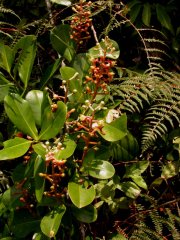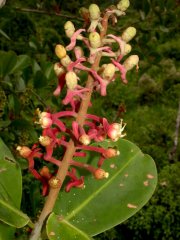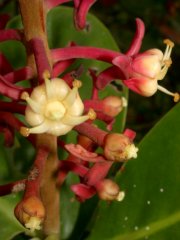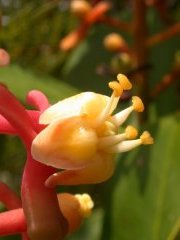 |
QUICK SEARCH
MO PROJECTS:
Africa
Asia/Pacific
Mesoamerica
North America
South America
General Taxonomy
Photo Essays
Training in Latin
America
MO RESEARCH:
Wm. L. Brown Center
Bryology
GIS
Graduate Studies
Research Experiences
for Undergraduates
Imaging Lab
Library
MBG Press
Publications
Climate Change
Catalog Fossil Plants
MO DATABASES:
W³MOST
Image Index
Rare Books
Angiosperm
Phylogeny
Res Botanica
All Databases
INFORMATION:
What's New?
People at MO
Visitor's Guide
Herbarium
Jobs & Fellowships
Symposium
Research Links
Site Map
Search
|
Draft Treatments | Guidelines | Checklist | Citing | Editors The Cutting EdgeVolume XI, Number 2, April 2004News and Notes | Recent Treatments | Leaps and Bounds | Germane Literature | Season's Pick | Annotate your copy SEASON'S PICK: Souroubea vallicola Woodson ex de Roon (Marcgraviaceae)
photos © B. E. Hammel, vouchered by Hammel et al. 22516 The Marcgraviaceae deserve to be featured here more often. This small family (125+ spp., among 7 genera; 27 and 6, respectively in Costa Rica) is restricted to the New World tropics, and has flowers that are not only quite showy in many cases, but also display fragrances with remarkable sweetness and intensity and of somewhat unexpected mixtures (especially in the genus Souroubea). The family is easily recognized by its usually epiphytic, often scandent habit; alternate, coriaceous leaves that are rolled in bud (as in Theaceae) with poriform glands on the lower surface; and especially for its nectar-producing, large and often oddly-shaped inflorescence bracts. Souroubea vallicola, our featured species for this season, flowers mostly during Costa Rica's dry season, from December through April, but sporadic flowering collections are known also through July, and from October. It is known from Pacific coastal mountains and lowlands to the south from San José, and from there on to Ecuador. The fragrance of this species has been described as "sweetly aromatic," and most recently as "sweetly aromatic of cinnamon and vanilla" (Hammel, pers. obs.). |
© 1995-2025 Missouri Botanical Garden, All Rights Reserved
4344 Shaw Blvd.
St. Louis, MO 63110
(314) 577-5100
Technical Support



